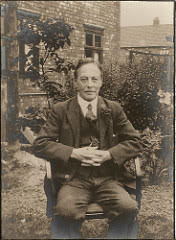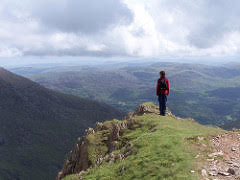1st March 2016
My Welsh Great-Grandfather

1 March is St David’s Day, named after the patron saint of Wales who died in 589. The Consulate in Istanbul and the Embassy in Ankara are flying the terrific Welsh flag:

I’m part-Welsh: my great-grandfather John Derfel (photo below) came from the the town of Llanderfel in north Wales and was the son of the Welsh poet and political writer Robert Jones Derfel (for the Welsh-language Wikipedia entry, click here). According to family lore, Robert Jones Derfel took the name “Derfel” because the winner of the Bardic poem at the national Eisteddfod, a Welsh festival of literature, music and performance, was encouraged to take his birthplace as a last name as a distinction. The name “Derfel” continues in our family to this day.

When I blogged about St David’s Day in 2013, I asked readers for connections between Wales and Turkey. A lady named Maria contributed this: “According to the 1861 Census for Wales, there were 5 Turks boarding in Cardiff, all merchant seamen, including a 20 year old, identified as P.M. from Constantinople, who spent the night of the Census in Cardiff Gaol. Not until 1901 do we see a boarding house keeper named Alix Asmile as a permanant resident. He lived at 12 Nelson St, Cardiff. Unfortunately, Alix (Ali) died in 1902 and his Welsh wife, Ellen, remarried in 1911. People born in Llanelli are known as ‘Turks’, probably because of the high numbers of Turkish mariners visiting the town.” I’d welcome any other contributions.
Finally, to anyone who has not visited Wales on holiday, I can recommend it, having spent my summer holidays there in 2009. A couple of photos illustrating the beauty of North Wales are below. It’s worth a visit.


A few other connections between Wales and Turkey, for example, Lady Layard, who was decorated by Sultan Abdulhamid II with the Order of Compassion (“Şefkat Nişanı” in Turkish) for her contributions to humanitarian relief efforts during the Russo-Turkish War of 1877–78. She was born in 1843 at Dowlais House, Merthyr Tydfil, South Wales.
(http://www.hurriyetdailynews.com/ottoman-medal-for-compassionate-british-lady-to-go-under-the-hammer.aspx?pageID=238&nID=77387&NewsCatID=385)
Also, Welsh-born poet, Arthur Symons, contributed many writings on Constantinople, originally published in Harper’s Magazine in 1903 (https://www.unz.org/Pub/Harpers-1903may-00863), however many excerpts have been recently included in An Istanbul Anthology: Travel Writing through the Centuries. Edited by Kaya Genç.
Here is an excerpt:
Pera, 1903
“The main street of Constantinople is the Grande Rue de Pera. I went into it first at night; there were but few shops open, a few men sitting on their chairs outside of the cafes, a few passers. Heaps of refuse lay in the gutters, dogs nosed into the refuse, dogs lay asleep in all the holes and jags of the pavement. As I passed, a strange dog was being led in leash through their midst, and a howling began which was caught up and continued along the street; dog after dog got up slowly and began to bark; there was a dense, uninterrupted noise, which I soon came to know as the unresting, inarticulate voice of the city.
Earlier in the evening, at the six-o’clock promenade, the Grand Rue de Pera is filled with people. There are a few Turks sitting at the cafes, tranquilly, with their cigarettes, watching the passers; poor men sit at the street corners, sweating and idle; hamals pass staggering under burdens, grape-sellers weighed down with deep hampers of grapes; tawdry shops are open, with dark young men lounging in the doorways; the red fez passers, with distrustful, disdainful, anxious eyes under it; but for the most part, in this crush and tangle of races, each elbowing the other in the slime of the street and against the shoulders of the trotting tram-horse, it is the European that one sees, — the Levantine, the Greek, the Armenian; women and girls, dark with profound eyes and empty faces, tightened into their smart dresses, walking slowly, cynically, with their free, hard roving eyes; young girls with superb hair and finely cut mouths, and neat, small firm figures; men with handsome, deceitful faces, odiously regular and lustrous; a slow, steady passing, uncomfortable and continuous.”
By Arthur Symons
Constantinople: an Impression, Harpers, 1903